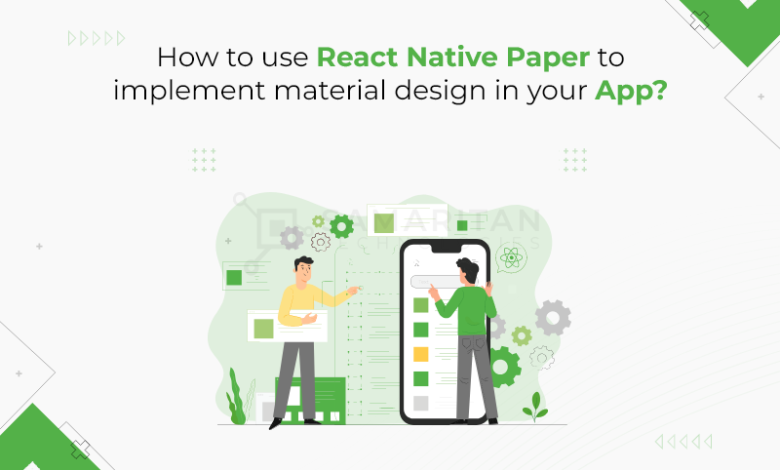
React Native apps that employ Material Design can improve user experience and expedite development. The well-known UI framework React Native Paper provides pre-built elements and styles to quickly implement Material Design concepts. We’ll look at using React Native Paper to include Material Design in your project in this post. We’ll walk you through every step of the process, from setting up the library to using its components for buttons, navigation, typography, and more.
Setting Up React Native Paper
React Native Paper is a popular library that allows you to build beautiful and consistent UI components following Google’s Material Design guidelines for your React Native app. Here’s a breakdown of the setup process:
- Installation:
Start by installing the react-native-paper package using npm or yarn:
npm install react-native-paper
Linking (Android only):
If you’re targeting Android, you need to link the native dependencies using the following command:
react-native link react-native-paper
- Usage:
Once installed, you can start using the various components provided by React Native Paper in your app. You can import individual components or the entire library:
JavaScript
import { Button, Text } from ‘react-native-paper’;
// or
import * as Paper from ‘react-native-paper’;
Then, simply render the components in your JSX code:
JavaScript
<Button mode=”contained”>Click me</Button>
<Paper.Text>This is some text</Paper.Text>

Implementing Material Design Components
Navigation: React Native Paper provides navigation components like Drawer, BottomNavigation, and Appbar to facilitate navigation within your app while adhering to Material Design principles. These components offer smooth transitions and consistent navigation patterns.
Buttons: Material Design emphasizes the use of prominent and visually distinct buttons for actions within an app. React Native Paper offers various button styles, including contained, outlined, and text buttons, allowing you to choose the most suitable option for your application’s design.
Typography: Consistent typography plays a crucial role in maintaining readability and visual hierarchy in your app. React Native Paper provides predefined typography styles based on Material Design guidelines, ensuring consistency across different screens and devices.
Cards: Cards are versatile components used to display content in a structured and visually appealing manner. React Native Paper offers a Card component that allows you to create cards with customizable content and styles, making it easy to present information in a visually engaging way.
Dialogs: Dialogs are used to communicate important information or prompt users for actions. React Native Paper provides a Dialog component that allows you to create dialogs with customizable content and behavior, sassa news ensuring a consistent and user-friendly experience.
Lists: Lists are a fundamental component for displaying information in a structured format. React Native Paper offers List and ListItem components that enable you to create lists with customizable content and styling, making it easy to present data efficiently.
Toolbars: Toolbars are used to provide access to app actions and navigation options. React Native Paper provides an Appbar component that allows you to create customizable toolbars with various actions, titles, and navigation options, following Material Design guidelines.

Customizing Material Design Components
While React Native Paper offers pre-defined styles and components based on Material Design guidelines, you may need to customize them to match your app’s specific design requirements. React Native Paper provides extensive theming and styling capabilities, allowing you to customize colors, typography, and other visual aspects to create a unique and cohesive design language for your app.
Integrating React Native Paper with Existing Components
If your app already includes custom components or utilizes third-party libraries, you can seamlessly integrate React Native Paper components with them. React Native Paper’s flexible architecture allows you to adapt existing components or combine them with third-party libraries, ensuring compatibility and consistency across your app.

Testing and Debugging
Once you’ve implemented Material Design components using React Native Paper, it’s crucial to test your app thoroughly to ensure compatibility and identify any potential issues. Testing should encompass various devices and screen sizes to guarantee a consistent user experience. Additionally, debugging tools provided by React Native and React Native Paper can help diagnose and resolve any encountered issues efficiently.
Performance Optimization
Optimizing performance is essential for delivering a smooth and responsive user experience. React Native Paper components are designed to prioritize performance, but you can further optimize your app by implementing best practices such as code splitting, lazy loading, and minimizing re-renders. Additionally, monitoring tools can help identify performance bottlenecks and optimize your app’s performance effectively.
Indicating the ROI of Outstanding UI/UX: Unlocking the Business Value. Have you ever wondered how your bottom line might be improved by investing in excellent UI/UX? Examine the data in detail to see the observable advantages. Great UI/UX is about generating actual outcomes, not simply pretty pictures.
It may boost customer happiness and conversion rates. Come along as we unravel the mystery behind the financial benefits of intuitive design and show you why every dollar you spend on UI/UX is an investment in long-term revenue. Let’s investigate the financial advantages of creating enjoyable user experiences.
The Business Impact of Great UI/UX
Beyond just aesthetics, great UI/UX design can have a profound impact on various aspects of a business, from customer satisfaction and loyalty to conversion rates and revenue generation. Let’s delve deeper into the business impact of great UI/UX:
Increasing Customer Satisfaction and Loyalty:
Great UI/UX design focuses on creating seamless and intuitive experiences for users. By streamlining navigation, reducing complexity, and ensuring accessibility, businesses can significantly enhance customer satisfaction.
Positive user experiences foster stronger emotional connections with brands, leading to increased loyalty and repeat business. When users find a platform easy to use and enjoyable, they are more likely to return and recommend it to others.
Increasing Conversion Rates and Revenue:
A well-designed UI/UX can directly impact conversion rates by guiding users through the sales funnel with clear calls-to-action and frictionless interactions.
By understanding user behavior and preferences, businesses can tailor their UI/UX to meet specific needs, thereby increasing the likelihood of conversions.
Higher conversion rates translate into increased revenue streams, demonstrating the tangible business value of investing in UI/UX optimization.
Reducing User Errors and Support Costs:
Poor UI/UX design can lead to user frustration, errors, and a higher incidence of support requests. Conversely, great UI/UX minimizes user errors by providing intuitive interfaces and clear guidance.
By reducing the need for user support and troubleshooting. Businesses can lower operational costs associated with customer service and technical assistance.
Investing in UI/UX improvements not only enhances user satisfaction but also contributes to cost savings and operational efficiency.



